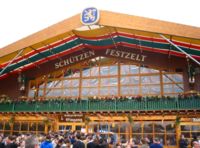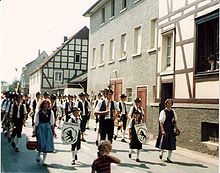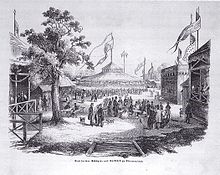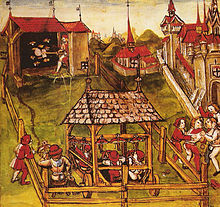- Schützenfest
-
A Schützenfest (German "marksmen's festival") is a traditional festival or fair featuring a target shooting competition in the cultures of both Germany and Switzerland.
At a Schützenfest, contestants compete based on their shooting abilities, for example by shooting at a wooden representation of an eagle. The winner of the competition becomes the 'Schützenkönig' ("king of marksmen") until the next year's competition.
The commercially organized Schützenfest of Hanover, Germany, is the largest marksmen's Fun Fair in the world with more than 5,000 marksmen, 250 rides and inns, 5 large beer tents and the "Marksmen's Parade". The parade with more than 10,000 participants from Germany and all over the world and more than 100 bands is 12 kilometres long. It is the longest parade in the world. The landmark of the funfair is the highest transportable Ferris wheel in the world. It is 60 metres high and can transport 420 people in 42 cabins.
Schützenfest Medals
Shooting competitions are a way of life in the Germanic regions of Europe, especially in Switzerland. The initial Swiss Federal Shooting Festival (Eidgenössisches Schützenfest) was held in 1824. Federal contests along with cantonal, city, and club competitions have continued through to the present day.
Various awards for marksmanship have been won by the competitors. Shooting medals and shooting cups are the most common forms of award. Books illustrating and listing these awards have been published in Switzerland.
Swiss shooting medals were struck in a variety of metals including gold, silver, bronze, white metal and aluminum, with silver being the most common. Mintages are very low with the average mintage of the 45mm silver being 700-800 pieces. The scarcity of medals has increased over the years due to the awards being melted for bullion, being lost, and general attrition. The size of most medals range from 23 millimeters to 62 millimeters with 45 mm being the most prevalent.
Also minted to commemorate the Shooting Festival were shooting thalers. Swiss shooting thalers began mintage in 1842, and continue being minted today. They can be distinguished from shooting medals by their uniform size and temporary legal tender status.
Contents
History
During the middle ages, many towns had to find ways to defend themselves from gangs of marauders. For this reason clubs and associations were founded, comparable to militias; these paramilitary associations were sanctioned for the first time in the Law for the Defensive Constitution of the Towns by King Henry I, and officially integrated into the towns' defense plans. Accompanying the military excercises and physical examinations of the towns' contingents, festivities were held combined with festive processions. Participants from other parishes and at times even the feudal heads of state were also invited to these Marksmen's Courts (Schützenhöfe). However, the self-confident spirit of the townsfolk that marked these festivities was not always regarded positively by the authorities. For this reason, different traditions developed in different regions. The military significance lessened over the course of the centuries and became meaningless with the creation of regular troops and garrisons for national defence. The Schützenfests however continued in the form of a regional patriotic tradition.
Germany
Schützenfests are celebrated mainly in Bavaria and Lower Saxony, but also in the Lower Rhine and Middle Rhine regions as well as in Westphalia(especially the Sauerland), with festive processions. Since German Reunification, Schützenfests have begun to emerge in eastern parts of Germany as well. The traditions connected to the Schützenfest can vary greatly from one region to another.
These traditions include the "Blow of the Flag" (a particular way of waving a flag). The Blow of the Flag in particular, as well as the waving of the flag in general are executed according to fixed rules. Competions are held in the discipline of flag waving.
Schützenfests may range from one day to several days and may include and be accompanied by various events. They often take place in the festival room of a local public house or in a pavillion especially erected for the occasion. In the Sauerland, many towns have a special Marksmen's Hall that is used for these festivities. Many Schützenfests start with a festive procession, whereby the reigning King of Marksmen, along with the royal household is picked up by the marksmen and paraded to the festive square or the festivities. This is often followed by a "royal parade" where the marksmen defile past the king. In a lot of cases, the pavilion is surrounded by a fun fair.
The most common form of shooting competition is the Bird Shooting. Nowadays the contestants no longer shoot at actual birds but on a mock bird made of wood and mounted on a pole. The contestant, who demounts the last pieces of the wooden bird is the new King of Marksmen. Varying traditions may include the shooting of wooden animals other than birds or special awards won by the shooting of certain body parts, e.g. wings, beak etc.
Notable German Schützenfests include
- The Hanover Schützenfest: The largest Schützenfest in the world, including platoons from all over Germany and the world
- The Neuss Schützenfest: The largest Schützenfest in the world that is organized by a single association and does not include platoons from other cities
Switzerland
Schützenfests played a central role in the Old Swiss Confederacy, during the 15th century, participants shooting the crossbow, contributing significantly to the coherence between the individual cantons. The Schützenfest of 1849 in Aarau figures prominently in Gottfried Kellers Das Fähnlein der sieben Aufrechten, where Keller portrays the shooting clubs as vital for the preservation of direct democracy in the young Swiss federal state. Today a Swiss Federal Schützenfest counts 50'000 marksmen during 4 weeks.
Eidgenössische (federal) Schützenfest are organized by the Schweizerischer Schützenverein since 1824.
- 1824 Aarau
- 1827 Basel
- 1828 Geneva
- 1829 Fribourg
- 1830 Bern
- 1832 Lucerne
- 1834 Zürich
- 1838 St. Gallen
- 1842 Chur
- 1849 Aarau
- 1859 Zürich
- 1861 Stans
- 1865 Schaffhausen
- 1867 Schwyz
- 1869 Zug
- 1872 Zürich
- 1874 St. Gallen
- 1876 Lausanne
- 1879 Basel
- 1881 Fribourg
- 1883 Lugano
- 1885 Bern
- 1890 Frauenfeld
- 1892 Glarus
- 1895 Winterthur
- 1898 Neuchâtel
- 1901 Lucerne
- 1904 St. Gallen
- 1907 Zürich
- 1910 Bern
- 1924 Aarau
- 1929 Bellinzona
- 1934 Fribourg
- 1939 Lucerne
- 1949 Chur
- 1954 Lausanne
- 1958 Biel
- 1963 Zürich
- 1969 Thun
- 1972 Biel
- 1977 Zürich
- 1985 Chur
- 1990 Winterthur
- 1995 Thun
- 2000 Bière
- 2005 Frauenfeld
- 2010 Aarau
Overseas
Schützenfeste organized by German or Swiss expatriate communities overseas:
Australia
Brazil
United States
- Auburn Hills, Michigan - Since 1939
- New Glarus, Wisconsin
- Altamont, Illinois
- Ehrhardt, South Carolina
- Cincinnati, Ohio (oldest in U.S. started in 1866)
- Deshler, Ohio
- Artemas, Pennsylvania
- Bow Valley, Nebraska
- Fredericksburg, Texas
- Grapetown, Texas
External links
Categories:- Shooting sports
- Swiss culture
- German culture
Wikimedia Foundation. 2010.




